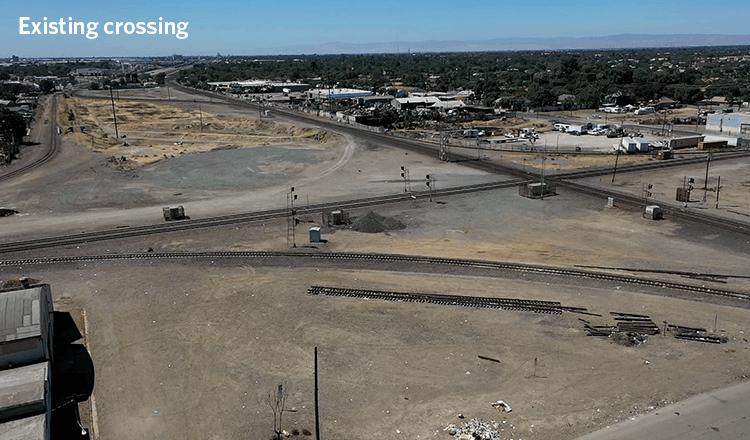Stockton Diamond Grade Separation

Stockton Diamond Grade Separation
Fixing the Busiest, Most Congested At-Grade Rail Junction in California
Today, the tracks of two major railroads intersect in Stockton, California, just south of the city’s downtown. This intersection, known as the Stockton Diamond, is the busiest, most congested at-grade rail junction in California.
Delays and backups at the intersection ripple throughout the region, affecting the movement of goods as well as passenger rail service that operates on the same rail lines. Separating the two lines and creating an uninterrupted flow of rail traffic is key to improving the efficiency and reliability of freight and passenger trains.
HDR was selected by the San Joaquin Regional Rail Commission to provide a wide range of services on the project, including public communications and outreach, traffic analysis and rail modeling of project scenarios, conceptual plans and alternatives development, preparation of the draft and final Environmental Impact Report and Environmental Assessment, as well as preliminary and final engineering and design for selected alternatives.
The project, with an estimated construction cost of $237 million, aims to separate the principal lines of BNSF Railway and Union Pacific Railroad at the Stockton Diamond. After preliminary scenario evaluation and railroad agreement, a flyover concept that places one rail line over the other has been selected as the most feasible. In this scenario, the north-south UP track will be placed above the east-west BNSF track on a structure to be built just to the east of current lines. Creating a structure on a new alignment will mean less disruption for current freight and passenger rail during construction.

A Coordinated Solution, Communicated to All
Coordination and communication have been paramount on the project, particularly given the aggressive schedule that called for completing environmental reports and preliminary design work in about 15 months, and final design in about 24 months. The rail lines are used by multiple entities, including the Class I freight railroads, regional passenger rail and the local commuter Altamont Corridor Express. The San Joaquin Joint Powers Authority, city of Stockton, San Joaquin Regional Transit District, Federal Railroad Administration and California High Speed Rail Authority all also must be kept up to date. Our team provides regular updates on the project to all stakeholders, helping to craft solutions and reach agreements between all the parties.
Communication with the public has also been key. Our strategic communications professionals have led the public outreach effort, including virtual meetings, a project website, development of educational material and more. As a major community project that will impact traffic, development and the city’s downtown area, many residents are understandably invested and interested in the process.
Local Benefits and Local Outreach
While the highest-profile section of the project is the rail line separation, Stockton residents will also see local road improvements. HDR is tasked with designing road, pedestrian and bicycle improvements at seven crossings affected by the project footprint. With fewer trains idling at crossings, air quality will also improve, as will the mobility of local drivers and pedestrians previously stopped at crossings.
Located in an area with a large homeless population and other traditionally underrepresented voices, a robust environmental justice process has been important. Our environmental justice experts have crafted a strong outreach process that includes soliciting input from those affected by the project and work with local agencies and nonprofits. The impact of this rail project could be very significant to area and its residents, and with that in mind, we are working closely with community leaders to assess the situation and develop actionable solutions.
Funding Application Support
The Stockton Crossing project was selected in September 2020 by the U.S. Department of Transportation for a $20 million Better Utilizing Investments to Leverage Development grant. The project was the only rail project in the nation selected for a BUILD grant in the funding cycle. HDR performed the cost analysis needed and assisted with other parts of the successful application.
A final Environmental Impact report developed in accordance with the California Environmental Quality Act was approved by SJRRC in 2021, and an Environmental Assessment developed in accordance with National Environmental Policy Act guidelines was approved by the California High Speed Rail Authority in 2022. Final design, right of way acquisition, environmental permitting, and utility coordination activities are in process, with construction expected to begin in 2024.






